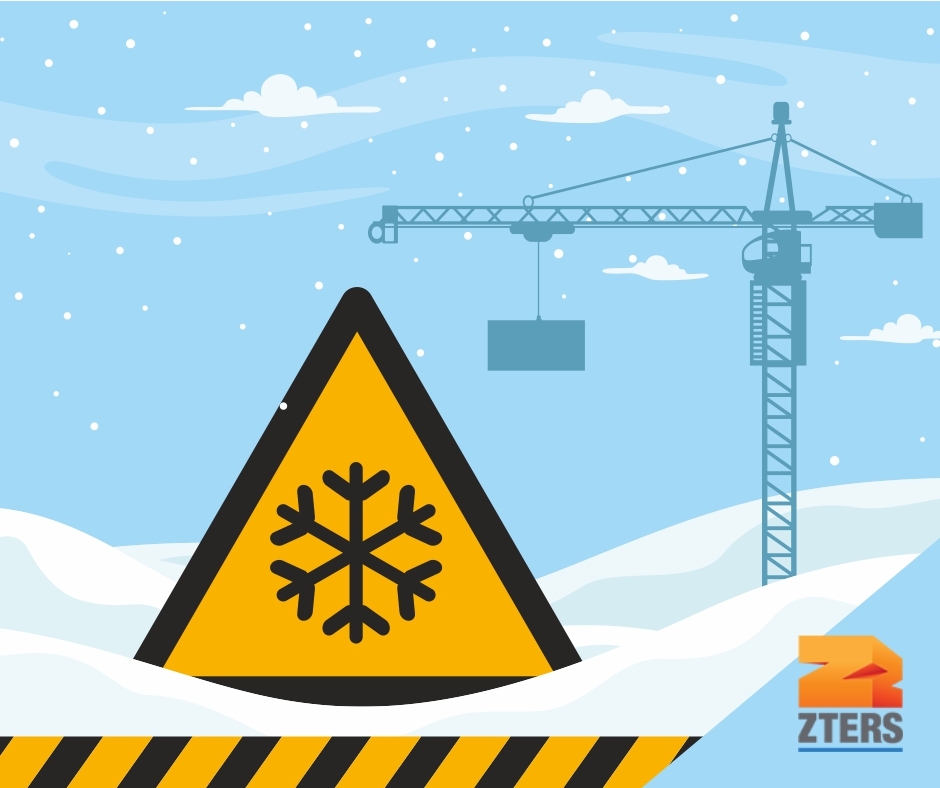As winter plunges many construction sites into wet and icy conditions, it’s crucial to prioritize cold weather safety measures. Ensuring the well-being of workers is as much a part of the job as streamlining a project.
The Occupational Safety and Health Administration (OSHA) outlines cold weather safety guidelines specifically designed to address the challenges posed by cold weather conditions.
Last year, we shared a post on how to prepare your construction site for winter. So now we’re going to dive into how to keep workers safe. Here are some invaluable winter safety tips for construction sites, alongside how partnering with ZTERS can support safety protocols this season.
Tips for Winter Safety on Construction Sites
1. Layer Up
Frigid temperatures demand adequate protection. Encourage workers to dress in layers, including thermal wear, moisture-wicking fabrics, and insulated outerwear. Proper gloves, hats, and footwear are indispensable in combating the cold. Do your research on the best cold weather gear to maximize comfortability while working. This is something worth investing in.
2. Stay Hydrated
Cold weather can mask the body’s need for hydration. Don’t underestimate your body’s need for water, especially if you’re exerting a lot of energy. Encourage regular intake of both cold and warm fluids to stay hydrated and prevent the risk of dehydration.
3. Know OSHA’s Cold Weather Guidelines
Familiarize yourself and your team with OSHA’s cold weather safety guidelines. Implementing these recommendations helps mitigate risks and ensures compliance with safety standards. Some of the highlights include:
- Know the symptoms of cold stress.
- Monitor your physical condition and that of your coworkers.
- Take regular breaks to warm up when needed.
- Dress properly for the cold.
- Stay dry in the cold because moisture or dampness, e.g. from sweating, can increase the rate of heat loss from the body.
- Keep extra clothing (including underwear) handy in case you get wet and need to change.
- Drink warm sweetened fluids (no alcohol).
- Avoid touching cold metal or wet surfaces with bare skin.
- Use proper engineering controls, safe work practices, and personal protective equipment (PPE) provided by your employer.
4. Schedule Breaks
Encourage frequent breaks in warm areas to prevent overexposure to cold temperatures. These breaks are essential for cold weather safety because they help maintain body heat and prevent conditions like hypothermia and frostbite. In addition, breaks can actually improve construction time management because workers will be feeling more energized after a short rest.
5. Routinely Inspect Equipment
One often overlooked aspect of cold weather safety is regularly inspecting and maintaining all construction equipment. Even portable toilets need winterizing, which ZTERS is here to help with. Cold weather can affect machinery and tools, leading to malfunctions or accidents if not addressed promptly. Just a little preventative care can help avoid any costly damage.
ZTERS Cold Weather Safety Solutions
Partnering with ZTERS can be a game-changer for winter construction safety. Our range of services, from optional climate controlled toilet trailers to ground-thawing solutions, can significantly enhance on-site safety and worker comfort. Here are some ways that ZTERS can help:
- Heated Toilets: Maintaining proper hygiene and comfort is crucial on construction sites. ZTERS’ climate controlled toilet options ensure facilities remain functional and comfortable for workers even in freezing temperatures.
- Ground Thawing: Frozen ground can hinder construction progress. ZTERS provides ground-thawing solutions that can be added to portable toilet solutions, enabling work to continue efficiently without delays caused by frozen surfaces that lead to backups.
Winter construction brings its own set of challenges, but with proactive measures, these challenges can be navigated effectively. Prioritizing worker safety and adhering to OSHA guidelines are important steps toward ensuring a safe and productive construction site during the winter months.
Remember, preparation is the key to conquering the cold and ensuring a successful construction project despite the freeze!

